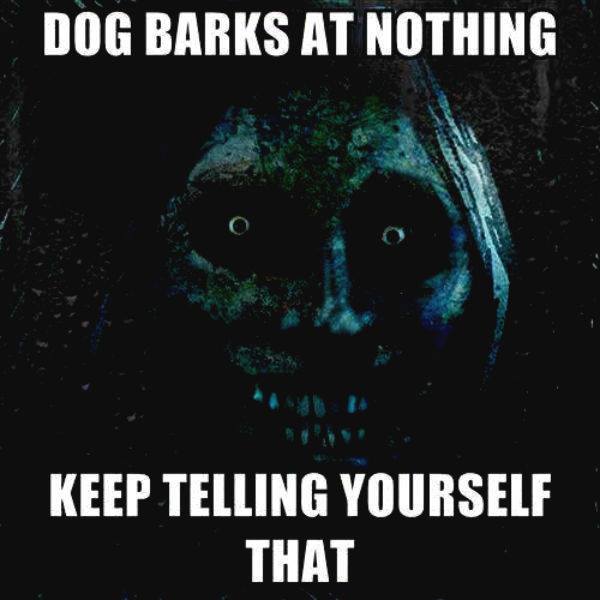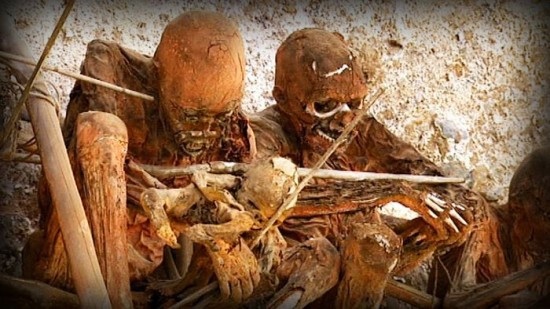It looks like you're using an Ad Blocker.
Please white-list or disable AboveTopSecret.com in your ad-blocking tool.
Thank you.
Some features of ATS will be disabled while you continue to use an ad-blocker.
share:
originally posted by: weirdguy
a reply to: Rainbowresidue
Papua New Guinea had many cannibal tribes even during WW2, they would eat the Japanese soldiers sometimes.
A friend of mine's grandfather fought in Iwo Jima. He told me a real horror tale of Japanese soldiers eating Americans. He said they rescued a man who had his legs eaten.
They put tourniquets above his knees, cut the legs off and ate them while he watched. They were keeping him alive to keep the meat fresh.
Way to make me puke. I gagged when I read about the cooking oil.
I find this awesome. Ok, smearing the "juices" on your relatives is a little crazy, but still interesting non the less. I don't know you guys, but I
love nature. If my family mummified my body, and put me in my favorite nature spot, I would be extremely grateful. Hmmm.... Although, I probably want
to just be put into a Mushroom Burial Suit when I die to give back to the planet. www.youtube.com...
edit on 2-8-2014 by Bongripasaurus because: video didn't work
originally posted by: Kangaruex4Ewe
For those of you interested in the mummification process that was and still is in use today... This should perk your brain right up! I always love learning about the rites and rituals concerning death in other cultures. I am amazed at how differently different cultures view and treat death compared to how we do so. Regardless of how different we all are, what our religion is, where we reside on this planet, and what we consider social norms... Death is one thing none of us will escape. It is indeed the great equalizer.
I ran across this and found it very interesting. I figured some here would as well, so I thought to share.
The Eerie Smoked Corpses Of Papua New Guinea
For centuries, the Anga tribe of Papua New Guinea’s Morobe Highlands have practiced a unique mummification technique – smoke curing. Once smoked, the mummies aren’t buried in tombs or graves; instead, they are placed on steep cliffs, so that they overlook the village below. The very sight of a string of charred, red bodies hanging off the mountains might seem quite grotesque, but for the Anga people, it’s the highest form of respect for the dead.
The process itself is carried out carefully and thoroughly by experienced embalmers. At first, the knees, elbows and feet of the corpse are slit, and the body fat is drained completely. Then, hollowed-out bamboo poles are jabbed into the dead person’s guts, and the drippings are collected. These drippings are smeared into the hair and skin of living relatives. Through this ritual, the strength of the deceased is believed to be transferred to the living. The leftover liquid is saved for later use as cooking oil.
I know here (in the US) that we shy away from death more so than most every culture in existence. It's not something we put on display. I found myself cringing while reading the details of how they prepare/d the bodies. One would wind up in a hospital somewhere here if they were to rub the deceased's body fat through their hair and on their skin here. For these people, it is a way to transfer the strength from the dead t7o the living.
Even mentioning using the leftover body fat for cooking oil here is beyond taboo.
In the next stage, the corpse’s eyes, mouth and anus are sewn shut, in order to reduce air intake and prevent the rotting of the flesh. This is believed to be the key step that ensures the mummies are perfectly preserved for centuries ahead. The soles of the feet, the tongue, and the palms are also sliced off and presented to the surviving spouse. The remains of the corpse are then tossed into a communal fire pit and smoke cured.
Once thoroughly smoked, the mummy is coated in clay and red ocher, which act as a natural cocoon, protecting the body from decay and scavengers. The process is now complete and the mummy is ready to go on display. Anga men, women and even babies are mummified using the same method; mummies dating back at least 200 years can still be found in the Morobe Highlands today. During celebrations and events, the mummies might be brought down from the cliffs, only to be returned soon after.
I can only imagine the trial and effort many cultures went through to find their preferred process of mummification. Using nothing high tech, they managed to find a simple, natural way to preserve the bodies of their dead. It's amazing that mummies can be found in such excellent condition after having centuries pass. These people still have mummies that are centuries old on display in their village.
The Anga mummification process can be a scary thing for people who don’t understand what the ritual is about. In fact, the curing was banned in 1975, when Papua New Guinea gained its independence. Today, many tribes perform Christian burials, and only a few tribes in remote pockets still prefer to mummify their dead.
It is definitely cringeworthy and I have to keep reminding myself that my way is not their way and visa versa. It's only cringeworthy because I picked up the idea that it is. I am sure our ways would have them cringing and wondering why we treat our deceased with such disrespect. Or why we hide them away instead of celebrating them.
I just thought it was an interesting topic. Hopefully a few of you will enjoy it as much as I did.
You can read more here:
www.odditycentral.com...
Yeah it is interesting how different some cultures are, id not seen this one though. Its like in japan they keep a room for their dead family members complete with ashes... If you were to visit the highest honer is for them to let you sleep in that room... Noice... lol
But yeah dragging your corpses down for a party is a bit hmmmmm lol
originally posted by: Meee32
Its like in japan they keep a room for their dead family members complete with ashes... If you were to visit the highest honer is for them to let you sleep in that room... Noice... lol
But yeah dragging your corpses down for a party is a bit hmmmmm lol
Yeah... That's not a nightmare waiting to happen is it?? Hi. I'm glad you came to visit! I gave you the suite with the bodies of those in our entire family tree that have passed on. Sweet dreams.
Yikes!!

This reminds me of the movie "Planet Terror" when JT, the owner of this barbecue shack has been looking for a secret ingredient to his barbecue sauce,
discovers that a zombie dripping into his sauce gives it that kick he's been looking for.
Never heard of anyone using body fat from the deceased for cooking oil before, but there was a wave of women consuming the ashes of their late husbands not too incredibly long ago..
EEK...
Never heard of anyone using body fat from the deceased for cooking oil before, but there was a wave of women consuming the ashes of their late husbands not too incredibly long ago..
EEK...
edit on 3-8-2014 by NoCorruptionAllowed because: spelling error
originally posted by: Hilux1996
a reply to: Hilux1996
Just remembered what that stuff they chewed was called. 'Beutal Nut'.
I think that's how it is spelled. I wonder if the corpses were covered in the stuff to give the red colour.
it's spelled "betel" and they do make you spit red, a lot! good quick buzz.
lol, i got some in china, they broke my upper in half.
really big biz in taiwan.
look up binlang on youtube.
not sure if they would use that but if they render the persons fat, i wouldn't be surprised.
smoking is a good way to preserve meat, which they must practice anyway.
I was not aware of this at all so thanks for the info. I always love learning about new things like this.
It's possible they smoked humans for consumption/preservation, fine tuned their technique that way.
Our friends make homemade jerky and fat is a no no. I think it will go rancid.
Interesting custom. Maybe the ground/rainfall doesn't allow for burial. Putting them up there raw wasn't the look they were going for.
Our friends make homemade jerky and fat is a no no. I think it will go rancid.
Interesting custom. Maybe the ground/rainfall doesn't allow for burial. Putting them up there raw wasn't the look they were going for.
new topics
-
Holy Cow! Erm...Six Legged Turkey!!
World Sports: 1 hours ago -
Ben Habib has Left Reform UK
Regional Politics: 4 hours ago -
Turkey Day Rhyme…
Short Stories: 4 hours ago -
Can someone please translate Biden's speech?
US Political Madness: 5 hours ago -
NIH Chief Confesses COVID Initiatives Were "Completely Made Up " OMG Investigates
Health & Wellness: 6 hours ago -
Awesome Dip Recipe
Food and Cooking: 9 hours ago -
Vladimir Putin's speech at the meeting of the CSTO Collective Security Council
World War Three: 9 hours ago
top topics
-
Happy Thanksgiving to ATS
General Chit Chat: 17 hours ago, 9 flags -
NIH Chief Confesses COVID Initiatives Were "Completely Made Up " OMG Investigates
Health & Wellness: 6 hours ago, 9 flags -
Vladimir Putin's speech at the meeting of the CSTO Collective Security Council
World War Three: 9 hours ago, 7 flags -
Can someone please translate Biden's speech?
US Political Madness: 5 hours ago, 7 flags -
Traveling the world with no passport
Social Issues and Civil Unrest: 13 hours ago, 6 flags -
Awesome Dip Recipe
Food and Cooking: 9 hours ago, 5 flags -
Turkey Day Rhyme…
Short Stories: 4 hours ago, 5 flags -
Ben Habib has Left Reform UK
Regional Politics: 4 hours ago, 4 flags -
Holy Cow! Erm...Six Legged Turkey!!
World Sports: 1 hours ago, 1 flags
active topics
-
Turkey Day Rhyme…
Short Stories • 4 • : JJproductions -
Awesome Dip Recipe
Food and Cooking • 4 • : texas thinker -
Mood Music Part VI
Music • 3721 • : BrucellaOrchitis -
NIH Chief Confesses COVID Initiatives Were "Completely Made Up " OMG Investigates
Health & Wellness • 10 • : ColeYounger2 -
Vladimir Putin's speech at the meeting of the CSTO Collective Security Council
World War Three • 52 • : Dalamax -
Traveling the world with no passport
Social Issues and Civil Unrest • 7 • : Flyingclaydisk -
Holy Cow! Erm...Six Legged Turkey!!
World Sports • 0 • : Flyingclaydisk -
V.P. Kamala Harris releases a video and nobody understands why
US Political Madness • 80 • : xuenchen -
Interesting Video-UFO?
Aliens and UFOs • 20 • : BrucellaOrchitis -
Happy Thanksgiving to ATS
General Chit Chat • 13 • : gort69


